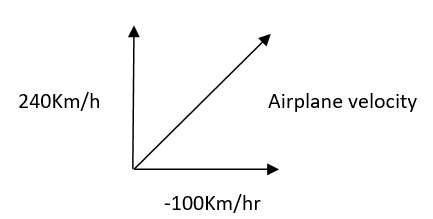
The compass needle of an airplane shows that it is heading towards the north and the speedometer measures the velocity of $240 kmh^{-1}$. Wind is blowing at $100 kmh^{-1}$ due east. Find the velocity of the airplane with respect to earth.
A) $260 kmh^{-1}, {23^0}$ east of north
B) $260 kmh^{-1}, {32^0}$ west of north
C) $260 kmh^{-1}, {23^0}$ west of north
D) None of these
Answer
220.8k+ views
Hint: The above problem is based on the vector subtraction and relative velocity concept. Airplane is heading towards north and wind is blowing towards east which means that velocity of airplane with respect to ground can be calculated by subtracting magnitude of velocity shown by speedometer and velocity of wind. Let’s get started with the vector subtraction to find out the speed of the plane with respect to round.
Complete step by step solution:
First let’s discuss vectors and relative velocity concepts in detail.
Vectors quantities are those which are characterised by both magnitude and direction. Vectors are represented by a line with an arrow head (which represents the direction of the vector).
Vector subtraction: The process of subtraction of one algebraic quantity from another is equivalent to adding the negative of the quantity to be subtracted.
The relative velocity is the velocity of an object or observer B in the rest frame of another object or observer A. Now, we calculate the velocity of the plane with respect to ground.

We will do vector subtraction by using the concept of Pythagoras theorem.
Velocity of an airplane will be denoted by $V_{ag}$ velocity of wind is $V_W$ and velocity of airplane $V_a$.
$
\Rightarrow {V^2}_{ag} = {V_a}^2 + {V_w}^2 \\
\Rightarrow {V_{ag}} = \sqrt {{V_a}^2 + {V_w}^2} \\
\Rightarrow {V_{ag}} = \sqrt {{{(240)}^2} + {{(100)}^2}} \\
$ (We have used the formula and substituted the value of velocities)
$
\Rightarrow {V_{ag}} = \sqrt {67600} \\
\Rightarrow {V_{ag}} = 260Km/hr \\
$ (We have done the square and added the value)
To find the angle of movement of airplane we will use
$
\Rightarrow \tan \theta = \dfrac{{{V_w}}}{{{V_a}}} \\
\Rightarrow \tan \theta = \dfrac{{100}}{{240}} \\
$ (We have use the tangent formula)
$
\Rightarrow \theta = {\tan ^{ - 1}}\dfrac{{100}}{{240}} \\
\Rightarrow \theta = 22.67 \\
\Rightarrow \theta = {23^0} \\
$
Option (A) is correct.
Note: Vector addition and subtraction can be done using two laws which are: parallelogram law of vector addition and triangle law of vector addition. In the triangle law of vector addition, the head of one vector is attached to the tail of another vector.
Complete step by step solution:
First let’s discuss vectors and relative velocity concepts in detail.
Vectors quantities are those which are characterised by both magnitude and direction. Vectors are represented by a line with an arrow head (which represents the direction of the vector).
Vector subtraction: The process of subtraction of one algebraic quantity from another is equivalent to adding the negative of the quantity to be subtracted.
The relative velocity is the velocity of an object or observer B in the rest frame of another object or observer A. Now, we calculate the velocity of the plane with respect to ground.

We will do vector subtraction by using the concept of Pythagoras theorem.
Velocity of an airplane will be denoted by $V_{ag}$ velocity of wind is $V_W$ and velocity of airplane $V_a$.
$
\Rightarrow {V^2}_{ag} = {V_a}^2 + {V_w}^2 \\
\Rightarrow {V_{ag}} = \sqrt {{V_a}^2 + {V_w}^2} \\
\Rightarrow {V_{ag}} = \sqrt {{{(240)}^2} + {{(100)}^2}} \\
$ (We have used the formula and substituted the value of velocities)
$
\Rightarrow {V_{ag}} = \sqrt {67600} \\
\Rightarrow {V_{ag}} = 260Km/hr \\
$ (We have done the square and added the value)
To find the angle of movement of airplane we will use
$
\Rightarrow \tan \theta = \dfrac{{{V_w}}}{{{V_a}}} \\
\Rightarrow \tan \theta = \dfrac{{100}}{{240}} \\
$ (We have use the tangent formula)
$
\Rightarrow \theta = {\tan ^{ - 1}}\dfrac{{100}}{{240}} \\
\Rightarrow \theta = 22.67 \\
\Rightarrow \theta = {23^0} \\
$
Option (A) is correct.
Note: Vector addition and subtraction can be done using two laws which are: parallelogram law of vector addition and triangle law of vector addition. In the triangle law of vector addition, the head of one vector is attached to the tail of another vector.
Recently Updated Pages
Two discs which are rotating about their respective class 11 physics JEE_Main

A ladder rests against a frictionless vertical wall class 11 physics JEE_Main

Two simple pendulums of lengths 1 m and 16 m respectively class 11 physics JEE_Main

The slopes of isothermal and adiabatic curves are related class 11 physics JEE_Main

A trolly falling freely on an inclined plane as shown class 11 physics JEE_Main

The masses M1 and M2M2 M1 are released from rest Using class 11 physics JEE_Main

Trending doubts
JEE Main 2026: Application Form Open, Exam Dates, Syllabus, Eligibility & Question Papers

Understanding Uniform Acceleration in Physics

Derivation of Equation of Trajectory Explained for Students

Hybridisation in Chemistry – Concept, Types & Applications

Understanding the Angle of Deviation in a Prism

How to Convert a Galvanometer into an Ammeter or Voltmeter

Other Pages
Thermodynamics Class 11 Physics Chapter 11 CBSE Notes - 2025-26

JEE Advanced Marks vs Ranks 2025: Understanding Category-wise Qualifying Marks and Previous Year Cut-offs

Units And Measurements Class 11 Physics Chapter 1 CBSE Notes - 2025-26

NCERT Solutions For Class 11 Physics Chapter 8 Mechanical Properties Of Solids

Motion in a Straight Line Class 11 Physics Chapter 2 CBSE Notes - 2025-26

Laws of Motion Class 11 Physics Chapter 4 CBSE Notes - 2025-26




